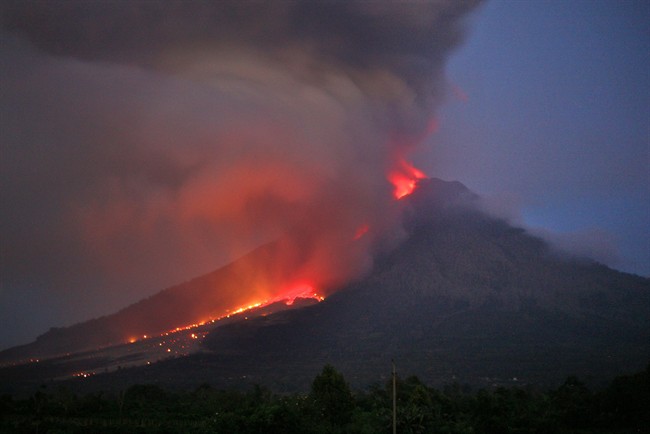MOUNT SINABUNG, Indonesia – A rumbling volcano in western Indonesia on Saturday unleashed fresh clouds of searing gas that killed at least 14 people and injured three, only a day after villagers who fled earlier eruptions returned home thinking it was safe, officials said.

The dead included four high school students on a school trip to see the volcano and a local journalist, said National Disaster Mitigation Agency spokesman Sutopo Purwo Nugroho. He said that the government on Friday allowed nearly 14,000 people living outside a five-kilometre danger zone to return home after the volcano’s activity decreased.
Mount Sinabung’s morning eruption was followed by a more powerful blast that sent lava and pyroclastic flows down southern slopes up to 4.5 kilometres away, Nugroho said. Television footage showed villages, farms and trees around the 2,600-meter-high volcano covered in thick grey ash.
Authorities were still preventing more than 16,000 villagers living along the path of hot clouds from going back to their homes, but many of them insisted on checking their houses and farms after more than four months of being crammed into temporary shelters. Authorities raised the alert status for Sinabung to the highest level in November.

Get daily National news
“The death toll is likely to rise as many people are reported still missing and the darkness hampered our rescue efforts,” said Lt. Col. Asep Sukarna, who led the rescue operation.
The number of evacuees rose to more than 30,000. Many wore masks to protect against the soot and sulfur-choked air. Food, emergency tents and medicine were sent to the area.
The latest eruptions came just a week after President Susilo Bambang Yudhoyono visited displaced villagers and pledged to relocate them to new plots with permanent housing.
The volcano’s last major eruption in August 2010 killed two people and forced 30,000 others to flee. It caught many scientists off guard because it had been quiet for four centuries.
Mount Sinabung is among about 130 active volcanoes in Indonesia and has sporadically erupted since September.
Indonesia is prone to seismic upheaval due to its location on the Pacific “Ring of Fire,” an arc of volcanoes and fault lines encircling the Pacific Basin.
Associated Press writer Niniek Karmini in Jakarta, Indonesia, contributed to this report.








Comments